June 27 Lava Flow Update – 2/20/15
Following Hawai’i County Civil Defense’s Friday morning overflight assessment of the June 27 lava flow, the agency reported that no change has occurred in any of the downslope portions of the flow.
Civil Defense reported that a breakout along the north margin of the flow was active and advancing, but no additional information on the rate of advancement was given.
The small breakout that was first reported Sunday, located about 600 yards upslope from the original stalled flow front, continues to show no progression. This portion of the flow was last tracked to have advanced on Monday morning.
Despite stalled advancement in the lower region of the flow, Civil Defense says that surface breakouts, along with breakouts along the north and south margins of the flow, show that lava is continuing to be supplied to the tube system from the source.
None of the activity associated with the flow is posing an immediate threat to communities in the area. Civil Defense, along with Hawaiian Volcano Observatory, will continue to monitor conditions and inform the public of any changes in activity.
Moderate smoke conditions were reported Friday morning as a light southwest wind was blowing in a northeast direction. As usual, these conditions have the possibility of changing and those who are sensitive or have respiratory issues are advised to take necessary precautions.
A brush fire that broke out on Thursday began as burning activity along the edge of one of the breakouts. Officials say that fire activity remains within the fire break area and is secured within the perimeter. No communities are currently under threat of a brush fire and conditions will continue to be monitored.
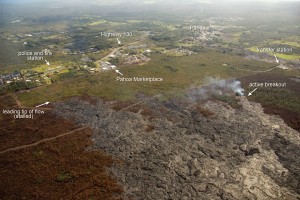
The leading tip of the June 27 flow has been stalled for several weeks, but scattered breakouts have persisted upslope. During an overflight on Feb. 19, one of these breakouts was active south of the stalled tip and about 650 meters (0.4 miles) northwest of the Pāhoa transfer station. USGS HVO photo.
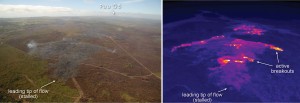
This comparison of a normal photograph and a thermal image, taken on Feb. 19, shows the position of active breakouts relative to the inactive flow tip. The white box shows the rough extent of the thermal image on the right. In the thermal image, active breakouts are visible as white and yellow areas. USGS HVO photos.
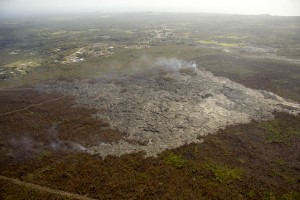
This photo, taken on Feb. 19 shows another view of the leading portion of the June 27 flow. Persistent breakouts a short distance upslope of the stalled tip have resulted in widening of this section of the flow. USGS HVO photo.

In this photo, taken on Feb. 19, another view of the leading portion of the June 27th flow, looking upslope. Pahoa Marketplace is in the lower right corner of the photograph. Mauna Loa can be seen near the top of the photograph. USGS HVO photo.
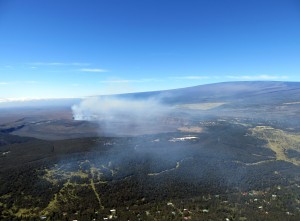
The winds on Feb. 19 were carrying the gas plume from Halemaʻumaʻu towards the northeast. Volcano Village is in the bottom portion of the photograph and Mauna Loa is in the upper right. USGS HVO photo.

This large-scale map uses a satellite image acquired in March 2014 (provided by Digital Globe) as a base to show the area around the front of Kīlauea’s active East Rift Zone lava flow. The area of the flow on February 10 is shown in pink, while widening and advancement of the flow as of February 19 is shown in red. The blue lines show steepest-descent paths calculated from a 1983 digital elevation model. USGS HVO map.

This map overlays a georegistered mosaic of thermal images collected during a helicopter overflight of the distal part of Kīlauea’s active East Rift Zone lava flow on February 19 at about 10:30 AM. The base image is a satellite image acquired in March 2014 (provided by Digital Globe). The perimeter of the flow at that time is outlined in yellow. Temperature in the thermal image is displayed as gray-scale values, with the brightest pixels indicating the hottest areas (white shows active breakouts). The blue lines show steepest-descent paths calculated from a 1983 digital elevation model. USGS HVO map.
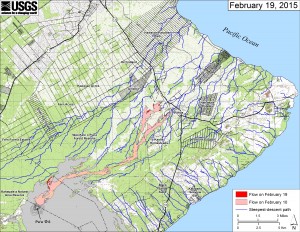
This small-scale map shows Kīlauea’s active East Rift Zone lava flow in relation to lower Puna. The area of the flow on February 10 is shown in pink, while widening and advancement of the flow as of February 19 is shown in red. The blue lines show steepest-descent paths calculated from a 1983 digital elevation model. USGS HVO map.













